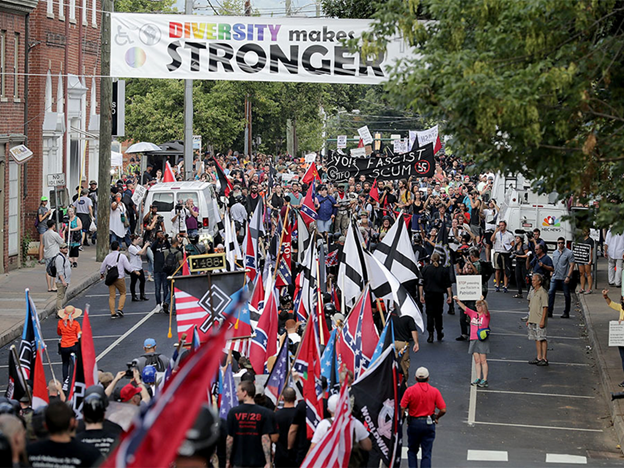This article was originally published August 18, 2017 on the Huffington Post.
By Joyce S. Dubensky, CEO, Tanenbaum.
Contributions by Liz Joslin, Senior Workplace Program Associate, Tanenbaum

The reverberations from Charlottesville keep coming. Among them, the many disturbing images including the photo above. It caught my attention, not only because it shows the stark divisions (and anger) that now define our country. But also, because I see the pairing of two potent symbols that today inspire fear and promote a vision of America that doesn’t include me, or anyone else who is not white.
Inside the square flag on the left side of the image, you can see the Othala rune. To be honest, I didn’t immediately recognize it (or know its official name), but I was still chilled by its visual similarities to the Nazi-style swastika. I learned that, historically, it represents the idea of “homeland” in ancient Norse.[i] In the twentieth century, though, it was appropriated by the Nazis and a slightly altered version was used on SS uniforms during the Second World War. Now, it is a popular symbol among neo-Nazis. To the extent it still is meant to reference “homeland” in any way, one thing is clear. It’s not a homeland where I am welcome.
Another prominent symbol in this image is more readily recognized—the Confederate flag. The Anti-Defamation League characterizes the flag as a hate symbol, but with an important caveat: “…because of the continued use of the flag by non-extremists, one should not automatically assume that display of the flag is racist or white supremacist in nature.”[ii] Additionally, in a 2015 poll, 57% of Americans said that the Confederate flag is more a symbol of southern pride than racism.[iii]
This history of symbols is worth knowing. The intention of those using a symbol matters. But right now, what matters more is the way these symbols make people feel. In Charlottesville, they were used, together, to intimidate not just Jews and African Americans, but anyone who does not fit the narrow definition of an American espoused by the Unite the Right protestors.
Recently, Tanenbaum released a guide for employers on religious icons and symbols in the workplace. We created this guide because a client wanted to know what do to about a car in an employee parking lot with a Confederate flag decal or license plate. At first, I was surprised by a question about the flag, given that our area of expertise is religion. But the truth is that these two symbols are now inextricably linked, and together give a message intended to threaten me. Protestors holding Confederate flags were chanting, “Jews will not replace us.” Of course, this is a Tanenbaum issue.
The Confederate flag has been an source of contention for years. I have no doubt that more questions about symbols and icons will arise in the coming weeks, because having a Confederate flag decal on your car today may be even more inflammatory and hurtful than just last week. It is naïve to suggest otherwise. Companies will need to make tough decisions about what it takes, and how far they are willing to go, to create workplaces that are safe and respectful for all employees. I do not ask them to ignore history or nuance. But I do ask them to prioritize the real fear for physical and emotional safety that many of us—and many of their employees—are feeling.
Joyce S. Dubensky, CEO, Tanenbaum
Contributions by Liz Joslin, Senior Workplace Program Associate, Tanenbaum